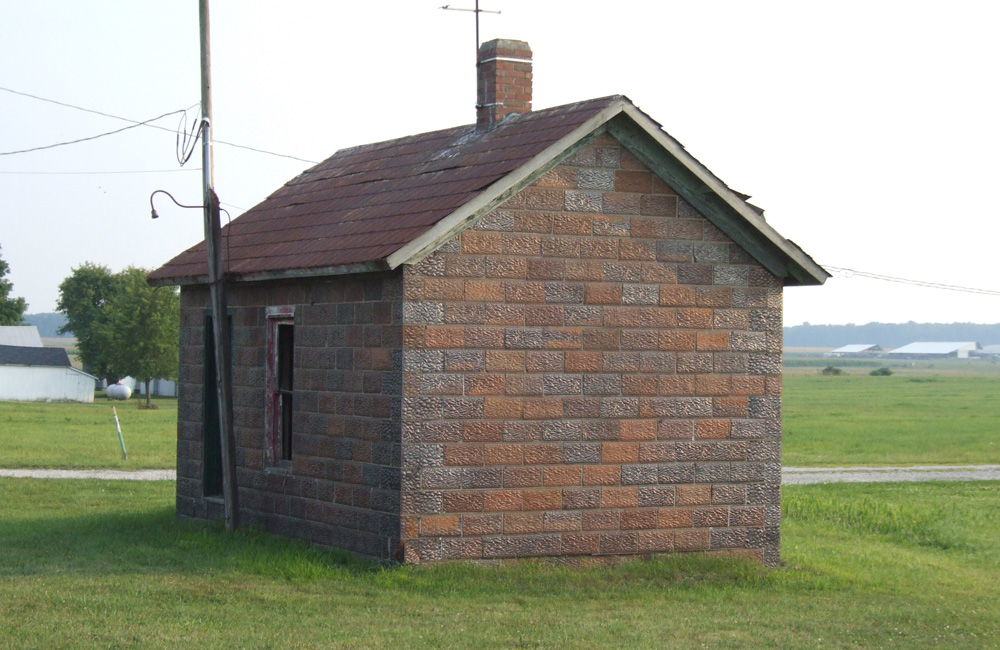
Q: I am researching and modeling Jefferson, Ohio. There are a number of buildings that are constructed from glazed block, as in this photo. I’ve seen the hobby manufacturers make all kinds of brick, stone and block sheet material, but I have not found material that looks like this. Do you have any ideas on how to model glazed block walls like this? – Chuck Beargie
A: There are three features you’ll have to reproduce to model glazed block walls: the color, the shine, and the texture. Color is easy enough if you have an assortment of red and brown hobby paints. After painting the blocks in varied colors and applying a mortar wash, you can reproduce the shiny highlights with an overcoat of thinned gloss medium. Hobbyists often use gloss medium to model water, so you might already have a bottle in your hobby supplies. I would thin the gloss medium 2:1 or 3:1 with distilled water, since what you want is a subtle shine; a thick coat will make your building look like it’s been covered in plastic wrap. You can always another coat of gloss medium if you want more shine, but if you put it on too thick to start with, trying to remove it will likely damage the paint underneath. Another option might be to spray or brush the material with a glossy lacquer like Testor’s Glosscote, but the thickness of the glaze might be hard to control.
The hard part will be reproducing the texture. Those blocks in your photo seem to have a rippled surface that reflects the light in waves and spots. I don’t know of any commercially available scale building material that has such a texture. However, in an internet image search, I found other glazed block walls that had a texture like cut stone. A cut stone wall material in a scale one step smaller than yours might work to model glazed block walls like that.
If reproducing the texture of the walls of the building in your photo is important to you, you might be able to simulate it by, before painting, texturing a styrene brick sheet with a material like spackling. Dab it with a wet sponge to give it a random texture, then after it dries, sand it lightly to round off any high points or sharp peaks. However, this runs the risk of filling in your mortar lines. And if you’re working in N or HO scale, the texture produced may be too coarse to look realistic.
Another option is to soften the surface of styrene brick sheet with a brushing of liquid styrene solvent cement, then jab at it with the tip of a plastic-bristled paintbrush (like these from Testor). The risk here is a thin brick sheet can distort or disintegrate under aggressive treatment or too much solvent. (Not to mention the risk of inhaling all those glue fumes; wear a mask and do this in a well ventilated area.)
A third option would be to spray your walls with a textured decor spray paint before brush-painting the individual blocks. The texture might come out a bit coarse and conceal your mortar lines, so test this technique on a piece of scrap material first. Maybe try spraying the wall sheet with regular red primer but hold the can farther back from the wall than you normally should. When I’ve done this accidentally, I sometimes end up with a pebbly finish that might be exactly what you’re looking for.
But if none of these ideas produce the texture you’re looking for, texturizing might not even be necessary. If you were to accurately scale down a block wall from its real world dimensions, the mortar grooves between the blocks would be barely perceptible. Model manufacturers exaggerate the width and depth of mortar lines on their structures to make them visible in smaller scales. This texture might be the same. Once you paint and glaze your block walls, they could look good enough to pass the three-foot test without texturing. Good luck.
Send us your questions.
Have a question about modeling, operation, or prototype railroads? Send it to us at AskTrains@Trains.com. Be sure to put “Ask MR” in the subject.













